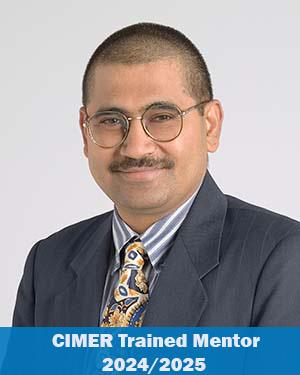Research News
04/16/2024
How to save a failing heart: internal investment shapes new drug development approach
Long-term collaborations created a new drug development approach to heart failure.

(Pictured above) A 3-D rendering of the beta-2 adrenergic receptor.
What started with $15,000 in internal funding has now led to a $1 million federal grant to support a therapeutic that re-sensitizes key receptors in a failing heart's cells. The therapeutic in development at Cleveland Clinic aims to solve a recurring problem with long-term heart failure treatment.
Patients are prescribed beta-blockers to lower blood pressure through regulating how fast and strong the heart beats. Beta-blockers may control blood pressure, but they don't address the underlying problem: that the receptors that innately regulate the heart's pressure aren't signaling appropriately and are impaired.
A $1.5 million grant from the National Institutes of Health awarded to Drs. Vara Prasad Josyula and Sathyamangla Prasad will support groundwork for a small-molecule therapeutic that re-activates beta-adrenergic receptors' sensitivity, critical to how our heart responds to stress.
"Some patients can take beta-blockers for years, but not all patients respond to the treatment long term," says principal investigator Sathyamangla Prasad, PhD. "In fact, our cardiovascular system looks to work around the beta-blockers by increasing the sympathetic overdrive to improve receptor function. By seeking to keep the receptors active, we are pursuing a solution to a problem that affects long-term health and quality of life."
Dr. Prasad's team and collaborators laid out how these sensors become desensitized and associated this pathway with heart failure, building a case for effectively targeting this pathway over seven years of preclinical research and drug discovery. The NIH grant will support developing candidate molecules that can reactivate beta-adrenergic receptors safely and effectively, setting the stage for potential future clinical trials.
"Everybody was willing to lend a hand when this was just an idea," Dr. Prasad says. "The consistent support was overwhelming and unexpected. So many players came together to make it happen through sharing their intellectual time."
The challenge: Keeping the heart steady
Beta-adrenergic receptors react to hormones like adrenaline, telling our hearts to pump more blood to the rest of the body as part of what's commonly called a "fight or flight response." This pathway is important in keeping our blood moving, but it also contributes to the early stages of heart failure.
During long periods of stress, beta-adrenergic receptors become desensitized (dysfunctional) due to consistently high levels of adrenaline in our systems. The receptors then require more hormone to activate, so our bodies make more adrenaline in response. Beta-blockers prevent further activation of these receptors when there is excess adrenaline in the system, and there are fewer functional receptors that can bind with adrenaline. The excess adrenaline furthers receptor desensitization and creates a damaging feedback loop that contributes to heart failure.
A drug that restores beta-adrenergic receptor sensitivity would provide a long-term solution for heart failure patients. The intervention would stabilize the entire process the body uses to keep blood flowing, Dr. Prasad says.

Co-principal investigators Drs. Sathyamangla Prasad (left) and Vara Prasad Josyula.
Investing in heart health
The investigation began as Dr. Prasad worked with Cleveland Clinic Innovations to develop intellectual property on the target he had discovered that might be important in heart failure. With its help, Dr. Prasad learned that the pathway was already a target for a newly designed molecule that was being tested in cancer. This could potentially fast-forward development of new drugs for heart failure, but there was a roadblock. The new molecule was not available. It was only in the earliest stages of testing.
Dr. Prasad's team needed to synthesize the molecule if he was going to be able to test it in heart failure. Through a collaborative program project with Serpil Erzurum, MD, a principal investigator in Inflammation & Immunity and now Cleveland Clinic's Chief Research and Academic Officer, Dr. Prasad received $15,000 in internal funding to synthesize the molecule and to test whether it could recover the beta-adrenergic receptor function, and reverse heart failure.
The molecule was synthesized at the Cleveland Clinic, and early tests by the Prasad team were promising. This led to a $160,000, two-year National Center for Accelerating Innovation (NCAI) federal grant to develop more evidence in support of proof-of-concept for using the molecule in preclinical models. Dr. Prasad worked with Cleveland Clinic's Center for Therapeutic Discovery and Vara Prasad Josyula, PhD, co-principal investigator on the project, to alter the existing molecule.
Developing molecules with a similar structure to the original shows that you can tweak the existing structure to make the small molecule more effective while maintaining the effect on the receptor, says Dr. Prasad. These altered molecules still had the same effect in preclinical models, indicating which pieces of the molecule's structure are essential. The molecules were the stepping stones for the new funding that will support the team through the next two to three years as they generate novel molecules that are better than existing analogs, Dr. Prasad says.
The goal is to generate about 80 molecules with a unique chemical structure that will be more effective, last longer and show lower levels of toxicity.
"This project shows the importance of finding a way to invest in your vision as a scientist," Dr. Prasad says. "Collaboration and patience can help you move past the obstacles and stay on the right track so eventually the initial spark of an idea can become a reality."
Featured Experts
News Category
Related News
Research areas
Want To Support Ground-Breaking Research at Cleveland Clinic?
Discover how you can help Cleveland Clinic save lives and continue to lead the transformation of healthcare.
Give to Cleveland Clinic